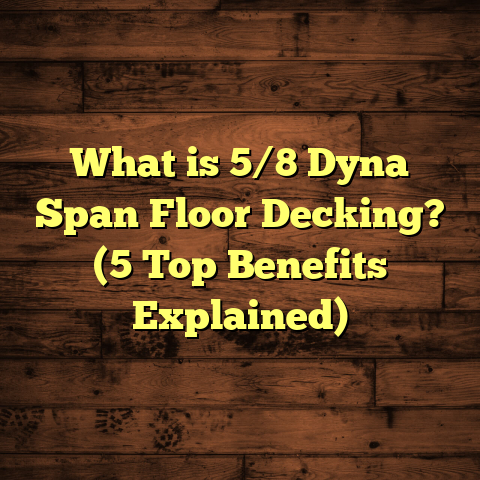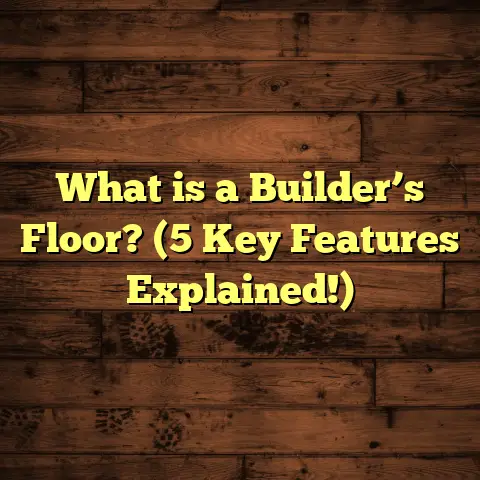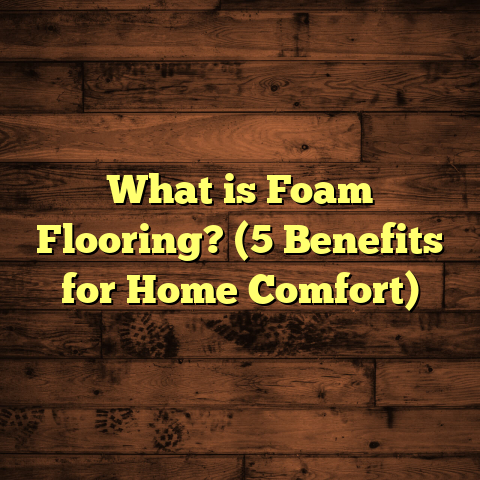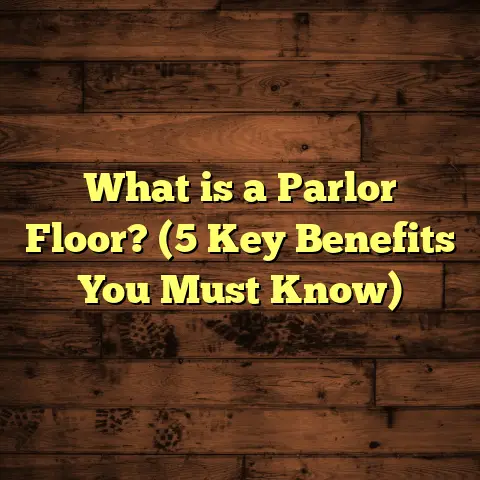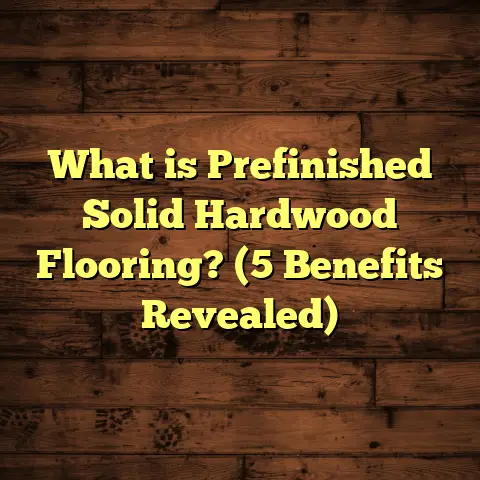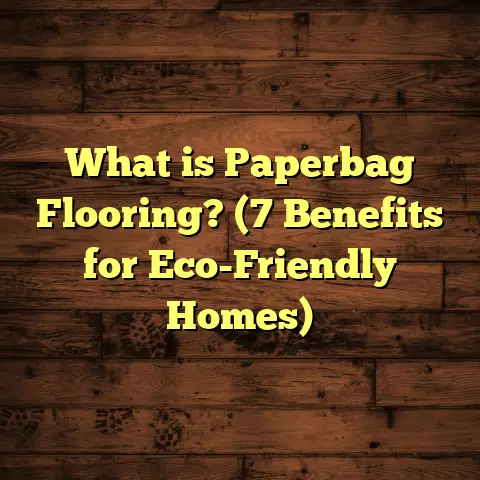What is an Alternative to the Floor? (5 Flooring Trends to Explore)
Future-Proofing Your Floors: Why Alternatives Matter
When I first started working in flooring over a decade ago, hardwood and tile were pretty much the go-to choices. They were classic, reliable, and looked great. But as time went on, I noticed something changing—not just the materials themselves but how people think about floors. More clients began asking me about options that could keep up with their busy homes, stand strong against pets or kids, and still look good years down the road.
That’s when I started pushing a bigger idea: future-proofing. What does that mean exactly? Well, for me, future-proofing means picking floors that won’t just survive wear and tear but will continue to fit your needs as your life changes. It’s about thinking ahead — not only about style but also durability, sustainability, and even installation methods.
I realized early on that sticking only to traditional choices limits possibilities. There are so many innovative alternatives to standard flooring out there. These alternatives often combine technology with design in ways that make them practical and unique. If you’re like me and want a floor that’s more than just a surface—something that stands the test of time—I encourage you to explore these options.
Let’s talk about what falls under “alternative flooring” and then dive into five exciting trends I’ve been working with lately.
What Is an Alternative to the Floor?
When I say “alternative to the floor,” I’m referring to materials or systems that aren’t your typical hardwood, tile, or carpet but still serve as a foundation for your living or working space. Alternatives can be innovative materials designed for specific benefits like water resistance or sustainability, or they might be new manufacturing processes that give floors unique qualities.
Alternatives can include:
- Composite materials like luxury vinyl planks made from PVC or wood-plastic composites.
- Natural but less common materials like cork or bamboo that offer different textures and sustainability benefits.
- Industrial creations such as polished concrete that provide durability and an urban look.
- Recycled materials like rubber flooring made from scrap tires.
What makes these options “alternative” isn’t just their makeup but their performance compared to conventional floors. For example, many alternatives offer better moisture resistance than hardwood or better sound absorption than tile.
Understanding the manufacturing process behind these materials gives you a clearer picture of what you’re getting. For instance, knowing that cork is harvested sustainably by stripping bark without cutting down trees adds an environmental appeal. Or that polished concrete involves grinding and sealing to create a smooth finish shows how craftsmanship affects durability.
I’ve found clients appreciate this level of detail because it helps them connect with the product on more than just an aesthetic level.
1. Luxury Vinyl Plank (LVP) Flooring: Style Meets Practicality
Luxury Vinyl Plank flooring has honestly transformed how I approach residential and commercial projects. At first glance, it looks like just another type of vinyl floor. But once you get into its layers and design technology, it’s clear why it’s become so popular.
How LVP Is Made
Luxury Vinyl Plank is built up in multiple layers:
- Backing layer: This is typically made from fiberglass or felt to provide dimensional stability.
- Core layer: Usually PVC or wood plastic composite (WPC). WPC combines wood fibers with plastic for added durability and a slightly softer feel underfoot.
- Design layer: A high-resolution photographic layer printed with images of real wood grains or stone patterns.
- Wear layer: A clear polyurethane layer infused with ceramic beads or aluminum oxide particles for scratch resistance.
The manufacturing involves extrusion of raw PVC into sheets or boards, followed by lamination where the design is applied and sealed under heat and pressure. The wear layer is crucial because it protects the floor from scratches, stains, and general wear.
Why Choose LVP?
From my work installing LVP in kitchens, basements, and even commercial spaces like retail stores, I’ve noticed several advantages:
- Water resistance: Unlike hardwood, LVP doesn’t swell when wet, making it ideal for moisture-prone areas.
- Durability: The ceramic bead-infused wear layer can withstand heavy foot traffic without dulling.
- Easy installation: Most products come in click-lock formats for floating floor installation, which reduces time and labor costs.
- Affordability: It’s generally less expensive than hardwood—both in materials and installation.
Real-Life Case Study
I worked with a family who was renovating their entire main floor. They had two dogs and a toddler who loved to spill drinks. Their main concern was durability plus comfort underfoot because of the kids. We chose a luxury vinyl plank with a thick wear layer and a WPC core. After two years of daily use and occasional accidents, the floor still looked brand new with minimal maintenance.
Cost Overview
For budgeting purposes, LVP usually runs between $2.50 to $5 per square foot installed. Labor costs vary by region but are typically lower than hardwood because of easier installation methods. Using tools like FloorTally helps me quickly estimate accurate costs based on local rates and specific product choices so I can present realistic budgets to clients without back-and-forth delays.
Maintenance Tips
One thing I always tell clients is to keep LVP clean by sweeping regularly and wiping up spills quickly with a damp mop. Avoid abrasive cleaners as they can degrade the wear layer over time.
2. Cork Flooring: Nature’s Cushion for Your Feet
Cork flooring has always fascinated me because it blends natural benefits with modern performance enhancements. It feels soft and warm underfoot—perfect if comfort ranks high on your list.
How Cork Is Made
Harvesting cork starts by stripping bark from cork oak trees every 9 years. This process doesn’t harm the tree, which continues growing bark for future harvests—a win-win for sustainability.
The bark is ground into granules then mixed with resin binders before being pressed into tiles or planks. Some manufacturers add protective coatings such as polyurethane or aluminum oxide finishes to increase durability and stain resistance.
Why I Recommend Cork
I’ve installed cork floors for home offices where clients wanted quiet spaces that absorb sound well but still have natural appeal.
Cork floors:
- Absorb sound waves efficiently—reducing noise by around 20 decibels.
- Provide thermal insulation; lab tests show cork can reduce heat loss by up to 40% compared to tile floors.
- Are naturally antimicrobial because cork contains suberin which resists mold and mildew.
Personal Experience
One client had chronic joint pain from standing on hard floors all day during work-from-home hours. After switching to cork flooring in their office, they reported noticeable relief due to cork’s slight cushioning effect.
Durability & Care
Despite being soft, cork floors are surprisingly durable if properly finished. They can handle moderate foot traffic but may dent under heavy furniture unless protected with pads.
Regular cleaning involves dry mopping or vacuuming plus occasional damp mopping with mild cleaners. Avoid excessive water to prevent swelling.
Cost Breakdown
Cork flooring typically costs between $4 and $7 per square foot installed depending on thickness, finish type, and geographic location. This puts it in a mid-range price point compared to hardwood and vinyl options.
3. Bamboo Flooring: Sustainability Meets Strength
If you’re looking for an eco-friendly option that doesn’t compromise on hardness or aesthetics, bamboo is one of my top recommendations.
The Bamboo Manufacturing Process
Bamboo is technically grass but grows incredibly fast—some species mature in as little as five years compared to decades for trees used in hardwood floors.
The manufacturing process includes:
- Harvesting mature bamboo stalks.
- Boiling them to remove sugars and starches that attract pests.
- Drying and cutting into strips.
- Laminating strips together under heat and pressure using adhesives.
- Strand-woven bamboo takes this further by shredding fibers then compressing them tightly before finishing—resulting in much harder planks.
Why Bamboo Stands Out
In one commercial project—a busy café—I installed strand-woven bamboo because it offers hardness comparable to some of the toughest hardwoods while being renewable.
Bamboo flooring is:
- Harder than many hardwood species; strand-woven bamboo scores around 3,000 to 4,000 on the Janka hardness scale (red oak scores about 1,290).
- Resistant to moisture better than traditional hardwood if properly sealed.
- Available in various finishes from natural blond tones to rich caramel colors.
Cost Considerations
Prices range from $3 to $7 per square foot installed depending on quality and finish. The environmental benefit adds value for clients focused on responsible sourcing.
Maintenance Tips
Like hardwood, bamboo should be cleaned regularly with a broom or vacuum and occasionally damp-mopped with pH-neutral cleaners designed for wood surfaces. Avoid excessive moisture exposure to prolong life.
4. Polished Concrete: Urban Chic & Durability Combined
Polished concrete has shifted from industrial warehouses into stylish residential spaces thanks to its minimalist appeal and durability.
The Polishing Process
Concrete slabs are poured using cement mixed with sand, gravel, and water then allowed to cure over weeks.
To polish:
- Heavy-duty grinders fitted with diamond abrasives smooth the surface starting with coarse grit progressing through finer levels.
- The surface is then sealed with penetrating sealers or topical coatings to protect against stains.
- Optional dyes or aggregates can be added during pouring for customized aesthetics.
I love how polished concrete creates seamless floors without grout lines—a huge plus for easy cleaning.
Practical Benefits
It’s extremely hardwearing—resistant to scratches, moisture damage, and heavy loads—which makes it perfect for high traffic zones.
A drawback is it can feel cold underfoot unless you add radiant heating beneath during installation. Also, it’s hard on joints if you stand for long periods without cushioning mats.
Cost & Installation Factors
Costs can run $3–$8 per square foot installed depending on prep work needed (like removing old floors), polishing complexity, and chosen finish.
Concrete floors can last decades with very little upkeep beyond occasional resealing every few years.
5. Recycled Rubber Flooring: Comfort With Eco-Friendly Vibes
Rubber flooring might remind you of gyms or playgrounds but it’s making waves as a home alternative too—especially in areas needing comfort underfoot combined with durability.
Manufacturing Recycled Rubber Floors
This involves collecting scrap rubber from tires or industrial waste which is cleaned then ground into granules. These granules are mixed with polyurethane binders and pressed into tiles or rolls.
The surface texture varies—from smooth finishes suitable for kitchens to textured non-slip surfaces common in gyms.
Why Rubber Makes Sense
Rubber flooring offers:
- Excellent shock absorption reduces fatigue during standing.
- Waterproof properties prevent damage from spills.
- Mold and mildew resistance.
- Slip resistance ideal for safety-conscious households.
One memorable install was in a home gym where clients loved the cushioned feel after workouts plus knowing their floor reduced landfill waste by repurposing tires.
Pricing Info
Expect $4 to $7 per square foot installed depending on thickness and finish options.
How I Use Tools Like FloorTally in My Projects
Estimating costs accurately is one challenge I face every day. Materials vary widely in price depending on quality, region, labor rates fluctuate, and overlooked waste can throw budgets off quickly.
That’s why I rely on FloorTally for most projects now. It lets me input local labor costs along with detailed material choices—like specifying click-lock luxury vinyl plank vs glue-down options—while automatically factoring in waste percentages based on installation type (cutting margins, damaged pieces).
This tool saves me hours of back-and-forth calls between suppliers and contractors trying to nail down numbers. It also helps clients visualize where their money goes so we can adjust specs if needed early in the process instead of after installation starts.
FloorTally feels like having a trusted assistant who keeps my budgeting sharp so I can focus more on choosing the right floor rather than crunching numbers all day.
Comparing These Alternatives: Which One Fits Your Life?
Choosing the right floor depends heavily on your lifestyle priorities:
| Material | Durability | Comfort | Water Resistance | Cost per Sq Ft Installed | Eco Friendliness | Maintenance Effort |
|---|---|---|---|---|---|---|
| Luxury Vinyl Plank | High | Medium | Excellent | $2.50 – $5 | Medium | Low |
| Cork | Medium | High | Good | $4 – $7 | High | Medium |
| Bamboo | High | Medium | Good | $3 – $7 | High | Medium |
| Polished Concrete | Very High | Low | Excellent | $3 – $8 | Medium | Low |
| Recycled Rubber | Medium | Very High | Excellent | $4 – $7 | Very High | Low |
Think about which features matter most: Is standing comfort essential? Do you need waterproof flooring? Is sustainability top priority? Or maybe your budget plays the biggest role?
Personal Thoughts on Future Trends
From my hands-on experience installing hundreds of floors across various styles and settings, one thing stands out: flooring innovation isn’t slowing down. New composites combining recycled plastics with natural fibers are emerging. Digital printing techniques now allow even more realistic textures in vinyl products.
I expect more smart flooring options incorporating sensors for temperature control or wear monitoring will appear soon too.
For now, exploring alternatives gives homeowners flexible choices tailored not just for today but years ahead—floors that age gracefully alongside your family without constant replacement headaches.
If you want more advice on any specific alternative floor type or help running numbers for your next project using tools like FloorTally, feel free to ask! Floors are foundational—in every sense—and picking wisely pays off big down the road.
